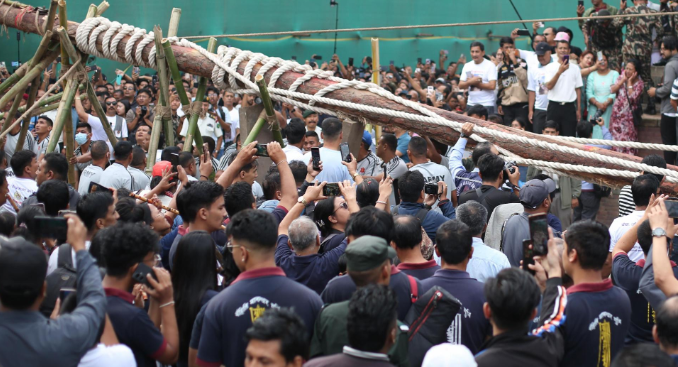The traditional Indra Jatra festival, celebrated for eight days in Bhaktapur, officially began on Sunday with the ceremonial raising of the Yambadya poles, symbolizing Lord Indra, in various parts of the city. The Yambadya, or Lingos, stand 15-16 feet tall and are set up on the first day of the festival, marking the start of the celebrations.
According to historian and cultural expert Dr. Purushottam Lohan Shrestha, the festival is observed annually on the 12th day of the waxing moon in the month of Bhadra. It is believed that on this day, Lord Indra is symbolically raised in the city, and the celebrations begin with rituals in various neighborhoods.
The second day of the festival is observed as ‘Diku’ or rest day, where only daily worship and evening aarti are performed for Yambadya. On the third day, a grand procession begins after sunset. The goddess Indrayani is placed on a chariot and taken through the city amidst music and fanfare. The procession, known as ‘Vacha Mukegu,’ culminates at Siddha Pokhari, where the deity is kept for the night, and a large fair is held.
On the fourth day, the people of Bhaktapur gather at Siddha Pokhari in the early morning to take part in the traditional ‘Indra Dah Snan,’ or bathing ritual. Residents flock to the pond from early morning to participate in this custom. The day concludes with a feast known as ‘Samay Baji,’ featuring special dishes such as Chwella, soaked peas, taro pickle, and cucumber. In the evening, the chariot of Indrayani is once again paraded through the city before being returned to the deity’s shrine.
The following days feature various other rituals. The fifth day includes regular worship and aarti. On the sixth day, the festival continues with significant celebrations, including the Salla Ganesh, Yamata, and Mupatra Jatras. On this day, the ‘Yamata,’ symbolized by a trident-shaped bamboo structure, is lit at Tachapal neighborhood, marking the beginning of the celebration. Large crowds gather at the Dattatreya Temple Square to witness the festivities.
On the seventh day, the Chhuma Ganesh from the Choche neighborhood and the Mupatra procession from Golmadhi make their rounds through the city. Mupatra, accompanied by two individuals, parades across neighborhoods, striking the Yambadya poles with a sword, a ritual that continues until the final day.
The grand finale takes place on the eighth day, with multiple processions, including the Bhairavnath Jatra, Pulubailadya Jatra, Yamata Jatra, Pulukisi Jatra, and Mupatra Jatra. The day begins with a grand procession of Bhairavnath from the Taumadhi neighborhood, where the deity is placed on a chariot and taken through the city. The local Mandharas from Tekhacho bring two Yamata poles to join the Bhairavnath procession, lighting them in front of Bulucha Hiti as part of the rituals.
In addition, the Pulubailadya Jatra, a representation of Bhairav drawn on a canvas, is held, while the Pulukisi Jatra—a celebration involving a white elephant figure—parades through the streets. At Bhairavnath Temple, a ritual involving a sword and Mupatra’s procession takes place, concluding the festival.
As per historian Dr. Shrestha, Indra Jatra dates back to the Dwapar Yuga but gained its present form during the reign of King Jagat Prakash Malla of Bhaktapur. The king compiled stories from the Devi Purana and Padma Purana and based the festival’s celebrations on these legends. The festival also recounts the tale of Lord Indra’s visit to Earth, his capture by locals, and his eventual release after intervention by his mother, Basundhara, marking it as a cultural and religious highlight of Bhaktapur.






